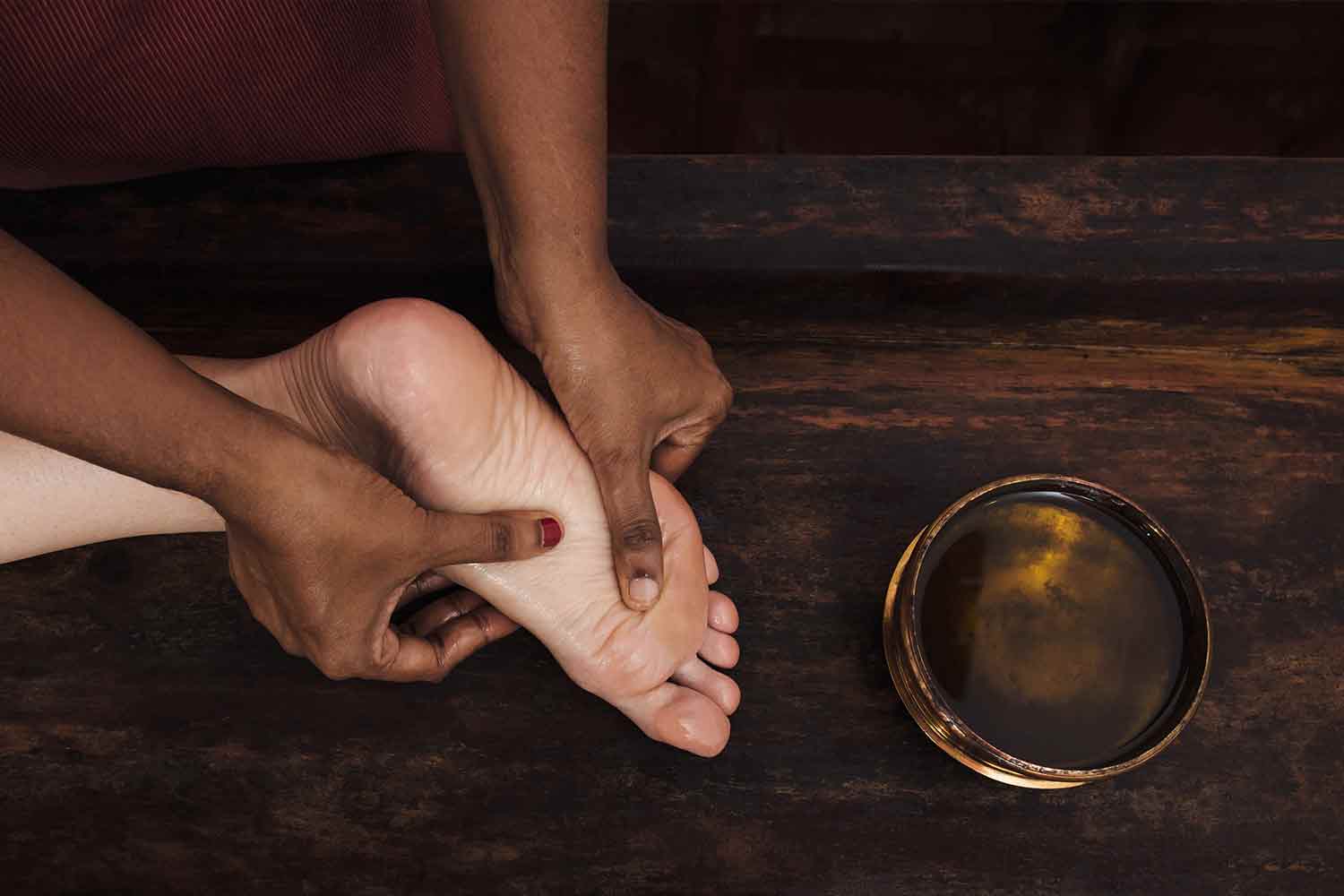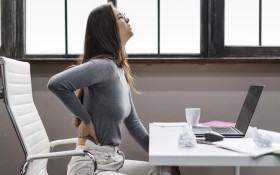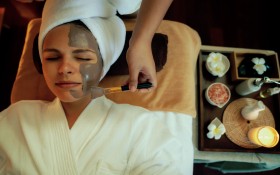
19
NovThe Healing Art of Pada Abhyanga Massage: An Ayurvedic Path to Wellness
Stress and tiredness have evolved practically inseparable with our daily life in the fast-paced environment we live in. Many people have been searching for natural and all-encompassing treatments to balance out stress. Pada Abhyanga massage is one such old technique that has endured over years. Based on Ayurvedic ideas, this foot massage has great health advantages in addition to relaxing value. Let's enter the revitalizing universe of Pada Abhyanga and investigate how it could be a transforming experience.
What is Pada abhyanga massage ?
Traditionally Ayurvedic foot massages, pada abhyanga massage emphasizes on activating the Marma points—energy points—on the feet. Derived from Sanskrit words "Pada" (foot) and "Abhyanga" (massage or oil massage), the title "Pada Abhyanga" emphasizes its central technique: gently and rhythmically applying herbal oils to the feet with soft strokes. Ayurvedic healing depends on the vital doshas, or energy channels, which are balanced by rubbing particular places on the feet.
The soothing and healing properties of this massage are well known; they affect not just the feet but also the entire body. Ayurveda generally advises it as a daily practice, especially as part of Soothika Paricharya (postnatal care) for newly mothers.
The Ayurveda Significance of the Feet
Ayurveda regards the feet as a map of the whole body, hence they have particular significance. Ayurvedic knowledge holds that every point on the foot corresponds to several organs and systems inside the body. Massaging the feet can thus help treat conditions all around the body. Pada Abhyanga uses well chosen oils to improve blood circulation, reduce stress, and encourage rest.
Ayurveda sees the feet as grounding points tying the body to the vitality of the earth. Carefully handled, the feet provide stability, balance, and mental clarity. Visiting an Ayurvedic massage centre for Pada Abhyanga might therefore enable you to harmonise your body and mind.
Pada Abhyanga Massage Improves Deep Relaxation and Helms Stress
Pada Abhyanga massage's slow, rhythmic motions gently calm the nerve system, therefore lowering anxiety and encouraging profound relaxation. Regular sessions help lower cortisol levels, the body's stress hormone, therefore enabling the body to mend and recover organically.
increases immunity and enhances circulation.
Pada Abhyanga's oils and mild pressure boost blood flow, which nourishes the tissues and aids in toxin flushing. This improved circulation boosts immunity, therefore strengthening the body's resistance to disease.
lowers inflammation and pain.
Pada Abhyanga lowers inflammation in the foot and lower legs, so providing comfort for persons with arthritis or joint pain. The anti-inflammatory qualities of the herbal oils applied in the massage help to lower swelling, ease pain, and increase mobility.
Especially helpful for balancing the Vata dosha, which, when inflamed, can cause problems including restlessness, dryness, and anxiety, Balances Vata Dosha Pada Abhyanga For anyone suffering an imbalance, this massage grounds and soothes Vata, making it the perfect treatment.
Improves the Quality of Sleep
Pada Abhyanga releases tension from the feet and calms the nerve system, therefore preparing the body for peaceful sleep. This Ayurvedic foot massage can help those who suffer with abnormal sleep patterns or insomnia great relief.
The Part Soothika Paricharya Plays in Postnatal Care
Ayurvedic postnatal care called Soothika Paricharya emphasises on healing and loving the newlywed mother. A woman's body changes greatly during the postpartum time; Ayurveda stresses the requirement of mild treatment to aid in recovery of the body. In this period, Pada Abhyanga is quite important since it helps restore physical strength, reduces stress, and promotes restfulness, so relaxing.
Pada Abhyanga is utilised in the framework of Soothika Paricharya to alleviate muscle tension and pain that newly mothers may go through. A great complement to postnatal recovery plans, it can also enhance general well-being and assist circulation. Experts in postnatal Ayurvedic treatment provide Pada Abhyanga at an Ayurvedic massage centre to assist women in successfully entering their new responsibilities.
Selecting Appropriate Ayurvedic Massage Centre
Selecting a reputable Ayurvedic massage centre where therapists are taught in real Ayurvedic practices is crucial if one wants to really enjoy the advantages of Pada Abhyanga. A respectable institution would follow Ayurvedic ideas and apply premium herbal oils in conventional manner. The therapist will make sure every session is very therapeutic, customise the massage according on your dosha, and grasp the energy spots of the body.
Effective treatment depends on quality substances, hence look for a centre open about the herbs and oils they employ. A qualified therapist will also be able to spot your particular demands and recommend a suitable massage frequency to maximise results.
What should one expect from a Pada Abhyanga Session?
Usually starting with a consultation whereby the therapist evaluates your dosha (Vata, Pitta, or Kapha) and notes any particular issues you might have, a Pada Abhyanga massage session This assessment guides their selection of a suitable herbal oil mix fit for your circumstances.
Working through each toe and with an eye towards the Marma points, the therapist gently, circular motions the soles of the feet throughout the massage. These locations are squeezed gently to relieve energy blockages and tension. Designed to send you into a state of great relaxation, the whole process is slow and meditative.
Warm towels placed on the feet allow the oils to enter deeply, therefore nourishing the skin and tissues, at the end of sessions. This all-encompassing method not only rejuvenates the feet but also leaves you feeling generally well.
How Often Should One Get Massages Using Pada Abhyanga?
Your own need will determine how often you should get Pada Abhyanga massages. For general wellbeing, one could just need one weekly session. More regular visits can help, though, if you are addressing particular difficulties including stress, sleep problems, or postnatal recovery. Ayurveda generally advises daily foot massages as part of a healthy lifestyle; hence, including Pada Abhyanga into your regimen can be a great way to keep balance.
Including Pada Abhyanga into Your Personal Hygiene Routine
Although a professional session in an Ayurvedic massage centre is best, you might also try basic foot massages at home. Warm some coconut or sesame oil then gently rub your feet with it. Pay especially attention to the arches, heels, and every toe. Though simple, this exercise can nonetheless help you relax and let you decompress after a demanding day.
See an Ayurvedic practitioner before beginning a Pada Abhyanga practice for people with certain medical needs or postpartum recovery. They can help you choose the correct oils, methods, and frequency appropriate for your constitution and wellness objectives.
Accepting Ayurvedic Knowledge for Whole Health
Ayurveda presents ageless knowledge that really speaks to current needs. Practices like Pada Abhyanga offer healing, grounding, and relief in a period when worry and tension are very common. Apart from relieving bodily pain, this age-old foot massage helps the mind to be balanced and peaceful.
Regular Pada Abhyanga massages can help you to attain a harmonic condition of health either in the comfort of your house or at an Ayurvedic massage centre. Pada Abhyanga can be a transforming experience whether your goals are postnatal care through Soothika Paricharya, relaxation, or a means of re-connection with your body.
Last Views
Sometimes the road to wellness calls for little, deliberate actions like Pada Abhyanga; other times, major changes are needed. Accept this Ayurvedic practice to develop awareness, lower tension, and improve general health. Ayurveda reminds us that since they help us through every stage of life, tending to our feet is like tending to our whole being.



